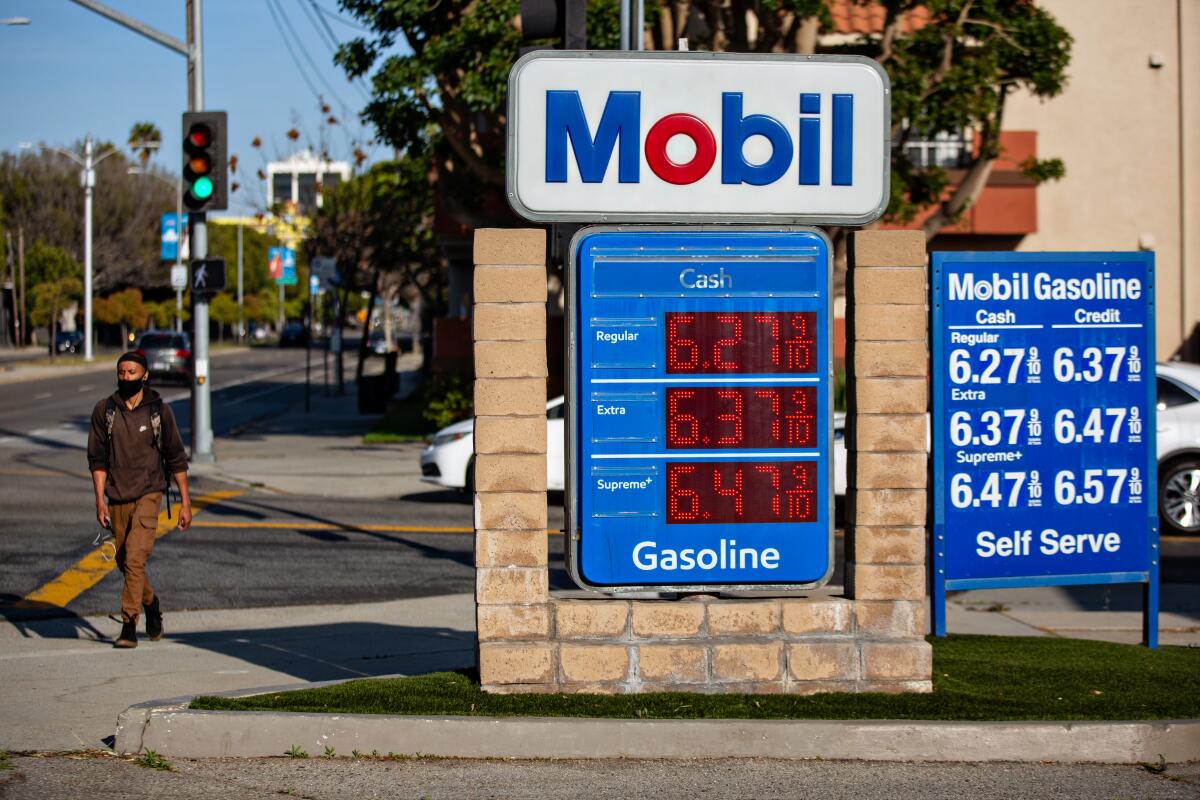Los Angeles average gas price leads the nation at a record-breaking $6.08

- Share via
On Wednesday the average cost for a gallon of regular gas in Los Angeles reached $6.08, leaping 2.3 cents overnight and breaking a record set earlier this year, according to the latest data from AAA.
Los Angeles is not alone in its pain as the cost of gas spikes across the nation. And according to analysts, the switch to a more expensive summer blend for other parts of the country promises the hurt will not stop anytime soon.
The average cost for regular gas is more than $4 for nearly every state. According to AAA, the national average is $4.56, but California leads the nation with an average of $6.05. Los Angeles gas prices last hit an all-time record on March 28 when the average reached $6.07, but Wednesday’s prices broke the record again after rising for 21 consecutive days. This time last year, the average cost of gas in Los Angeles was $4.17, according to historical data, and just last month was $5.80.
Other parts of the Golden State are paying even higher prices for a gallon of regular: The average in San Luis Obispo and Inyo counties reached $6.24 and $6.23, respectively, , while Mono County’s average reached $7.00 on Thursday. Multiple factors play into higher prices across the state, including higher taxes and shipping costs to more remote parts of the state.
A smorgasbord of other issues has driven up gas prices across the globe, including the war in Ukraine, which has seen the international market cut ties with Russia’s oil supply, and global supply chain issues that have carried over to ports and are then passed on to consumers. California’s unique blend of cleaner fuel costs more to produce and the cost of living in the Golden State also raises prices, along with inflation.
Automobile Club of Southern California spokesperson Marie Montgomery said there’s also been a reduction in oil refining in the United States, which creates the need to bring in more fuel from outside markets.
“We are going to need to attract that much more in imports to make up for the lack of refining capacity,” Montgomery said.
There’s also fear of a diesel shortage in other parts of the country that’s playing into the volatility in the oil market. Last year, the United States saw a steady increase in gas prices, and that ramped up at the start of the war in Ukraine.
“The uncertainty is really what’s driving the prices up,” Montgomery said.
AAA spokesperson Andrew Gross says the high cost of oil is driving the price at the pump.
Typically, there is a slight dip in gas prices around this time of year, but that doesn’t seem to be playing out this year.
“Even the annual seasonal demand dip for gasoline during the lull between spring break and Memorial Day, which would normally help lower prices, is having no effect this year,” Gross said in a statement.
The nationwide switch to the more expensive summer blend, which is meant to reduce gasoline evaporation when outside temperatures rise, is expected to be complete in early June. That switch has already started in most parts of the country, Montgomery said, and is already baked into the prices consumers are seeing at the pumps in California.
More to Read
Sign up for Essential California
The most important California stories and recommendations in your inbox every morning.
You may occasionally receive promotional content from the Los Angeles Times.











